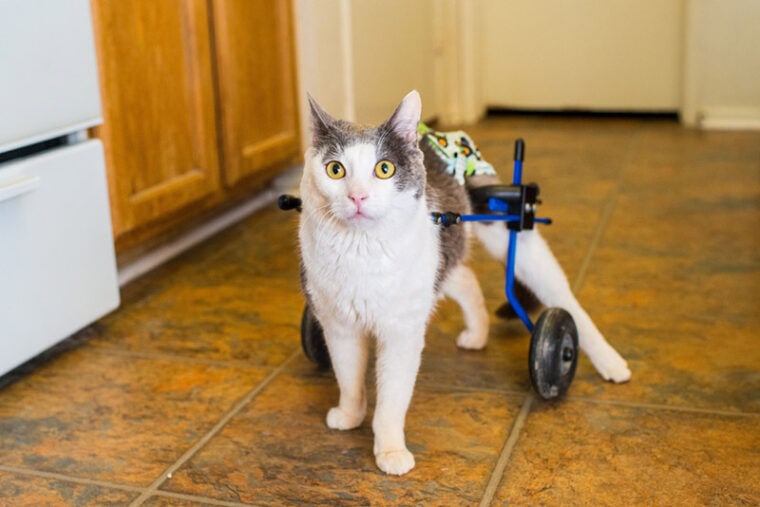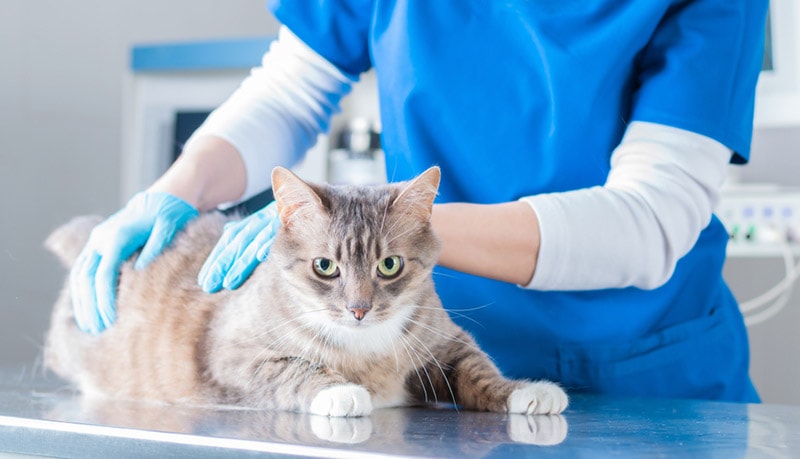
Paralysis in a cat can be incredibly alarming. Although relatively uncommon, hind leg paralysis is considered a medical emergency and should prompt immediate veterinary attention. There are many implicating factors, such as the underlying cause and severity of the paralysis. Unfortunately in many cases, while recovery is technically possible, the prognosis for paralysis in cats is relatively poor.
What Causes Hind Leg Paralysis in Cats?
To gain a deeper understanding of how paralysis happens, let’s discuss the nervous system. It involves two main components: the central nervous system (the brain and spinal cord) and the peripheral nervous system (nerves and muscles). These work together in harmony to enable the body to feel, move, and essentially function.
The brain is the central hub that coordinates bodily function, and it uses the spinal cord to send signals out to the body. The peripheral nervous system uses the spinal cord to send information back to the brain. If we were to visualize nerve transmission as silver sparks of electrical signals, our bodies would be constantly alight, with sparks traveling down from the brain and up from our feet, hands, and organs. It is a beautiful feat of biology. However, when it stops working as it should, the results can be catastrophic.
There are many causes of hind leg paralysis in cats, some being more common than others:

What Are the Signs of Leg Paralysis in Cats?
Depending on the underlying cause, hind leg paralysis can either come on suddenly (acute) or slowly, becoming worse over time (chronic). Complete and sudden paralysis will involve a complete lack of movement in the hind limbs and often an inability to feel sensory stimulus or pain. The legs may feel cold to the touch, and your cat may have no control over their bladder or bowels, causing them to urinate or defecate involuntarily. They may also have difficulty breathing.
Sometimes, clinical signs of paralysis are more subtle, especially if it starts slowly. Your cat may simply be a bit wobbly, dragging one or both legs behind them. They may also have difficulty jumping up onto surfaces, climbing stairs, or controlling their bladder.
What Will My Vet Do to Determine the Cause of Leg Paralysis?
A great deal of information about your cat’s history can be ascertained by the physical exam. Your vet will immediately begin to narrow down the possible causes of the hind leg paralysis simply by gathering information about your cat and doing a thorough examination on presentation to the hospital. To get a complete picture of your cat and hopefully confirm the cause of paralysis, the diagnostics usually involve:

What Is the Treatment for Leg Paralysis in Cats?
Treatment depends on the condition that caused paralysis in the first place. In effect, the paralysis is an isolated symptom that will hopefully be reversed if the underlying cause can be rectified. However, in the case of paralysis, this isn’t always possible. As a result, the cat may be permanently paralyzed, have a continued abnormality in their gait, or need aid with basic functions, such as urinating, for the rest of their lives.
Spinal cases often aren’t as simple as this, though, and usually require intensive hospitalization and supportive care, as other body systems, such as the bladder and the lungs, can be implicated in paralysis patients. Although cats are known for rallying when the “going gets tough,” humane euthanasia is sometimes required in severe cases, on the grounds of patient suffering.
A common cause of sudden feline paralysis in the hind legs is the aptly named “saddle thrombus.” It is caused by a blood clot, often a result of underlying heart disease, that travels from the heart and becomes lodged in the aorta. This blocks the blood supply to the back legs and causes sudden paralysis and severe pain. If treatment is recommended, it usually involves administering an anti-clotting agent and providing intensive care.
If your cat does make a recovery, they will likely be on anti-clotting medicine and medication to treat any underlying heart disease for the rest of their life. Lifestyle adjustments, such as keeping your cat indoors and frequent evaluations, are often necessary too, as these blood clots have a high rate of recurrence. Unfortunately, the prognosis is poor for these patients.1
What Is the Likelihood That My Cat Will Make a Full Recovery?
The severity of the paralysis is what indicates whether your cat will make a full recovery. Some cats can regain function, especially if they receive veterinary attention within the first couple of hours of paralysis. However, it is entirely dependent on the underlying condition and the progress that your cat makes in the first several hours of treatment.
Each case is extremely different, and as with most medical maladies, recommendations will be tailored to your cat’s individual requirements and your own circumstances. In most cases of paralysis, treatment often requires a serious investment of time and money. Therefore, developing an honest and trusting relationship with your veterinarian is essential.

Final Thoughts
Here are a few tips for keeping your cat healthy and safe:
Featured Image Credit: Casey Elise Christopher, Shutterstock







